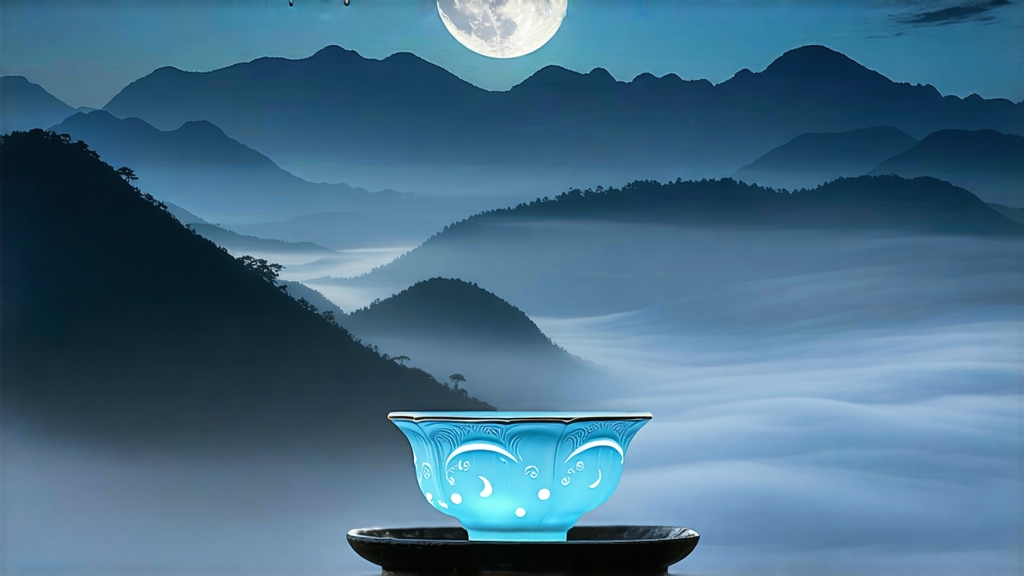
Tucked high in the cloud-veiled mountains of southern Yunnan, where the Mekong bends like liquid jade and the air smells of pine and wild orchid, a tea is born in secrecy. Farmers call it Yue Guang Bai—“White Moonlight”—because the leaves never meet the sun. Instead they are picked at dusk, carried in bamboo baskets lined with banana leaf, and allowed to rest under the open sky while the moon climbs above the forest canopy. By dawn the buds have turned the color of polished silver; by the next dusk they have mellowed into a soft, shadowy grey-green that seems to hold the night inside it. To the Western eye the finished tea looks almost unfinished: slightly curled, downy, with the matte pallor of river stone. Yet in the cup it releases a liquor so luminous that early British plant hunters mistook it for a white wine of the Himalayas.
Yunnan’s tea chronicles mention moonlight withering as early as the Daoguang era (1821-1850), but Yue Guang Bai only stepped onto the world stage in 2003, when a small factory in Jinggu County experimented with leaving newly plucked da bai (big white) buds outdoors during the full-moon nights of late March. The result was a tea that combined the honeyed tranquility of Fujian white tea with the malt and rose nuances of Yunnan’s indigenous broad-leaf cultivars. Word spread along the Tea Horse Road; soon connoisseurs in Seoul, Berlin and San Francisco were asking for “that moonlight stuff.” Today production is still tiny—less than fifteen tons a year—because the picking window is barely seven nights long and only the youngest one-bud-one-leaf pairs qualify.
The cultivar itself is a landrace known locally as Jinggu Da Bai Hao, a close cousin of the famous Fuding Da Bai but adapted to 1,800-meter elevations, cooler nights and ultraviolet levels strong enough to thicken the leaf cuticle. The bushes grow wildish in red lateritic soil among fragrant magnolias and insect-buzzing coffee shrubs, creating a polyculture that translates into layered cup character. In early spring the buds swell to almost three centimeters, sheathed in a velvet so dense it can be brushed onto paper like powdered pearl.
Craft begins the moment the moon edges above the ridge. Pickers wear headlamps filtered with red film so as not to shock the leaf cells; any green light, farmers insist, “makes the tea think it is daytime.” Baskets are never piled higher than ten centimeters to prevent bruising. Back at the farmhouse the leaves are spread on raised bamboo trays inside an open-walled pavilion where mountain air moves horizontally, gentle and cool. For roughly eight hours they lie beneath the stars, losing moisture in slow motion while indigenous yeasts and enzymes nudge the leaf chemistry toward lactones and terpene alcohols—the molecules responsible for white tea’s signature peach-coconut aroma. Just before sunrise, when dew begins to form, the trays are carried indoors and stacked in a shaded loft for another twelve hours of “quiet resting.” No heat, no rolling, no machine intervention: only the whisper of altitude and time. Finally the leaves are given a thirty-minute “moon bake,” a low-temperature desiccation at 35 °C using charcoal made from wild cherry wood, enough to drop the moisture to 5 % without locking the surface. The entire cycle is governed by lunar phases; if clouds obscure the moon the batch is abandoned to become black tea instead. Purists claim they can taste the difference between a full-moon and half-moon lot: the former deeper, the latter more floral.
Because Yue Guang Bai is minimally processed it forgives steeping errors that would ruin a green tea, yet rewards attention with quiet revelations. The international brewing consensus is 4 grams per 150 milliliters, but the leaf is so bulky that a heaping tablespoon already weighs five. Water just off the boil—95 °C—shocks open the downy buds, releasing a plume of aroma that carries night-blooming jasmine, baked almond and the faintest trace of pipe tobacco. First infusion: thirty seconds. The liquor glows like pale chardonnay and tastes of honey on warm slate. Second infusion: forty-five seconds; a note of fresh lychee appears, plus the cooling camphor that Yunnan teas inherit from their jungle terroir. By the fifth infusion the cup turns transparent again, but sweetness lingers on the sides